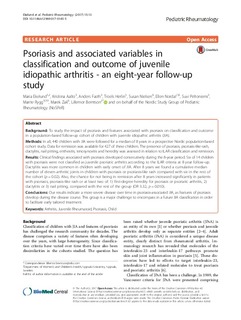| dc.contributor.author | Ekelund, Maria | |
| dc.contributor.author | Aalto, Kristiina | |
| dc.contributor.author | Fasth, Anders | |
| dc.contributor.author | Herlin, Troels | |
| dc.contributor.author | Nielsen, Susan | |
| dc.contributor.author | Nordal, Ellen Berit | |
| dc.contributor.author | Peltoniemi, Suvi | |
| dc.contributor.author | Rygg, Marite | |
| dc.contributor.author | Zak, Marek | |
| dc.contributor.author | Berntson, Lillemor | |
| dc.date.accessioned | 2018-01-02T14:26:54Z | |
| dc.date.available | 2018-01-02T14:26:54Z | |
| dc.date.created | 2017-08-09T12:56:56Z | |
| dc.date.issued | 2017 | |
| dc.identifier.citation | Pediatric Rheumatology. 2017, 15:13. | nb_NO |
| dc.identifier.issn | 1546-0096 | |
| dc.identifier.uri | http://hdl.handle.net/11250/2474132 | |
| dc.description.abstract | Background
To study the impact of psoriasis and features associated with psoriasis on classification and outcome in a population-based follow-up cohort of children with juvenile idiopathic arthritis (JIA).
Methods
In all, 440 children with JIA were followed for a median of 8 years in a prospective Nordic population-based cohort study. Data for remission was available for 427 of these children. The presence of psoriasis, psoriasis-like rash, dactylitis, nail pitting, enthesitis, tenosynovitis and heredity was assessed in relation to ILAR classification and remission.
Results
Clinical findings associated with psoriasis developed consecutively during the 8-year period. Six of 14 children with psoriasis were not classified as juvenile psoriatic arthritis according to the ILAR criteria at 8 year follow-up. Dactylitis was more common in children with early onset of JIA. After 8 years we found a cumulative median number of eleven arthritic joints in children with psoriasis or psoriasis-like rash compared with six in the rest of the cohort (p = 0.02). Also, the chance for not being in remission after 8 years increased significantly in patients with psoriasis, psoriasis-like rash or at least two of: 1) first-degree heredity for psoriasis or psoriatic arthritis, 2) dactylitis or 3) nail pitting, compared with the rest of the group (OR 3.32, p = 0.010).
Conclusions
Our results indicate a more severe disease over time in psoriasis-associated JIA, as features of psoriasis develop during the disease course. This group is a major challenge to encompass in a future JIA classification in order to facilitate early tailored treatment. | nb_NO |
| dc.language.iso | eng | nb_NO |
| dc.publisher | BioMed Central | nb_NO |
| dc.rights | Navngivelse 4.0 Internasjonal | * |
| dc.rights.uri | http://creativecommons.org/licenses/by/4.0/deed.no | * |
| dc.title | Psoriasis and associated variables in classification and outcome of juvenile idiopathic arthritis - an eight-year follow-up study | nb_NO |
| dc.type | Journal article | nb_NO |
| dc.type | Peer reviewed | nb_NO |
| dc.description.version | publishedVersion | nb_NO |
| dc.source.volume | 15 | nb_NO |
| dc.source.journal | Pediatric Rheumatology | nb_NO |
| dc.source.issue | 1 | nb_NO |
| dc.identifier.doi | 10.1186/s12969-017-0145-5 | |
| dc.identifier.cristin | 1485171 | |
| dc.description.localcode | © The Author(s). 2017 Open Access This article is distributed under the terms of the Creative Commons Attribution 4.0 International License (http://creativecommons.org/licenses/by/4.0/), which permits unrestricted use, distribution, and reproduction in any medium, provided you give appropriate credit to the original author(s) and the source, provide a link to the Creative Commons license, and indicate if changes were made. | nb_NO |
| cristin.unitcode | 194,65,15,0 | |
| cristin.unitname | Institutt for klinisk og molekylær medisin | |
| cristin.ispublished | true | |
| cristin.fulltext | original | |
| cristin.qualitycode | 1 | |

